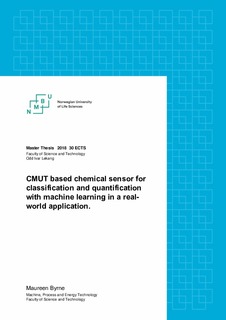| dc.contributor.advisor | Odd Ivar, Lekang | |
| dc.contributor.author | Byrne, Maureen | |
| dc.date.accessioned | 2018-09-09T13:01:06Z | |
| dc.date.available | 2018-09-09T13:01:06Z | |
| dc.date.issued | 2018 | |
| dc.identifier.uri | http://hdl.handle.net/11250/2561582 | |
| dc.description.abstract | In a quest for further enhancing human senses, chemical sensors are developed. Chemical sensors are proved to diagnose diseases, classify and quantify chemical warfare agents as well as measuring air pollution down to parts per billion [1-3]. Connecting multiple devices in large networks can help authorities and governments respond faster and make better decisions considering the release of emissions and/or dangerous gases. In order to create such networks, an inexpensive, robust and portable sensor must be developed. The chemical capacitive micromachined ultrasonic transducer (CMUT) might be such a sensor.
This thesis demonstrates a proof of concept for a CMUT based chemical sensor as a gas detecting unit that can classify and quantify chemicals with machine learning in a real-world application. The CMUT is a sensor consisting of an array of polymer coated cells adsorbing different gases. Adsorption causes a frequency shift in the sensor output. This shift can be correlated to chemicals and their concentrations through machine learning. Reference data collected for the machine learning models was identified as a time-consuming process. An autosampler was devised, reducing time and cost related to the data collection. The CMUT sensor was tested in a greenhouse for 4 weeks to measure CO2 concentration in a plant bed under varying conditions. Testing the following statement: If the sensor can detect low concentrations of CO2 in ambient air it can also detect other compounds. The machine learning models were trained on the collected samples, and later compared to find the best model.
The results showed that the CMUT sensor successfully measured CO2 down to 120 ppm in ambient air, the machine learning models could classify between high and low concentrations. For classification purposes the neural network with relu activation showed the best results, with a 15% error for both high and low concentrations. Quantification of the data had poor performance due to sensor drift. Large RMSE scores was found for all quantification models. The drift is most likely caused by the breakdown of the polymer, causing a frequency shift. The dataset was unbalanced and had a higher distribution on lower concentrations. Which to some extent undermine the results from the machine learning, although giving an indication of sensor performance. Further research is recommended to assess the polymer coating on the CMUT as well as removing drift. Reducing the size of the sensor and equipment, as well as connecting the sensor to a cloud database, is recommended and identified as important steps for creating a sensor network. | nb_NO |
| dc.description.abstract | I søken etter å forbedre menneskets sanser ønsker man å utvikle kjemiske sensorer. Kjemiske sensorer har blitt brukt til å diagnostisere sykdommer, klassifisere og kvantifisere nervegass i tillegg til å måle luftforurensing som har svært lav oppløsning. Ved å sette sammen flere elektroniske neser i større nettverk vil det bidra med økt informasjon om utslipp i byer. Dette vil hjelpe myndigheter med å ta bedre og raskere beslutninger for å unngå spredning av farlige kjemikalier og/eller forurensning. For å lage slike nettverk må sensorene som benyttes være pålitelige, kostnadseffektive og robuste. En sensor som oppfyller disse kravene er den kjemiske kapasitive mikromaskinerte ultralyd transduceren (CMUT). | nb_NO |
| dc.language.iso | eng | nb_NO |
| dc.publisher | Norwegian University of Life Sciences, Ås | nb_NO |
| dc.rights | Attribution-NonCommercial-NoDerivatives 4.0 Internasjonal | * |
| dc.rights.uri | http://creativecommons.org/licenses/by-nc-nd/4.0/deed.no | * |
| dc.title | CMUT based chemical sensor for classification and quantification with machine learning in a real-world application | nb_NO |
| dc.type | Master thesis | nb_NO |
| dc.description.localcode | M-MPP | nb_NO |

